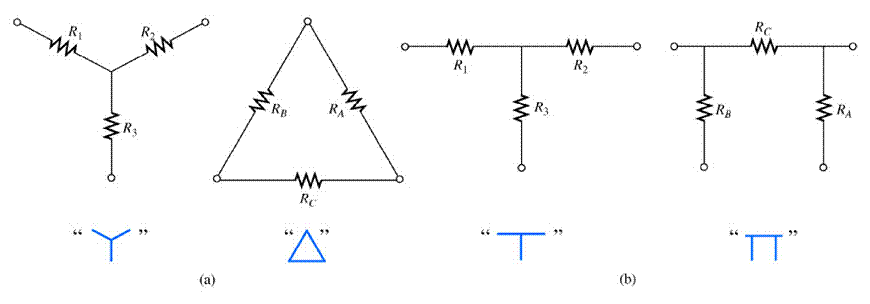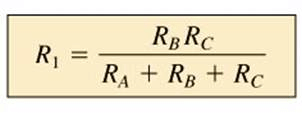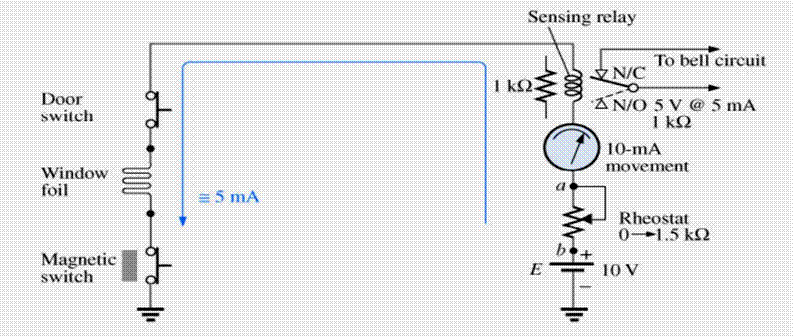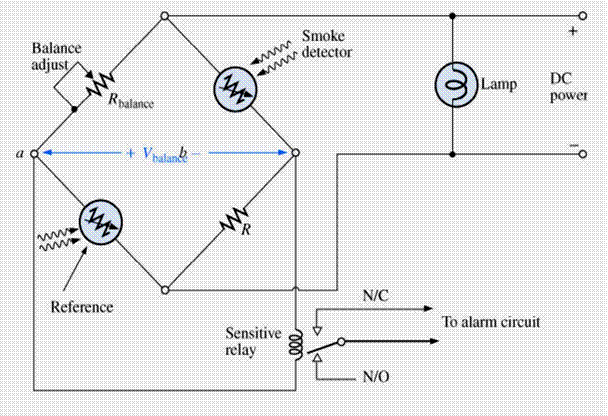Chapter 8 : Methods Of Analysis, PPT, Introductory Circuit Analysis, Semester, Engineering - Electronics and Communication Engineering (ECE) PDF Download
Chapter 8 - Methods Of Analysis
and Selected Topics [dc]
Introductory Circuit Analysis ---------------------------------------------------- Next Slide ------------------------------- Robert L. Boylested
8.1 – Introduction
- Methods of analysis have been developed that allow us to approach in a systematic manner a network with any number of sources in any arrangement.
The methods covered include branch-current analysis, mesh analysis and nodal analysis.
Introductory Circuit Analysis ---------------------------------------------------- Next Slide ------------------------------- Robert L. Boylested
8.2 – Current Sources
- The current source is often described as the dual of the voltage source.
- A battery supplies a fixed voltage, and the source current can vary; but the source supplies a fixed current to the branch in which it is located, while its terminal voltage may vary as determined by the network to which it is applied.
Introductory Circuit Analysis ---------------------------------------------------- Next Slide ------------------------------- Robert L. Boylested
Current Sources
A current source determines the current in the branch in which it is located
- The magnitude and polarity of the voltage across a current source are a function of the network to which it is applied
Introductory Circuit Analysis ---------------------------------------------------- Next Slide ------------------------------- Robert L. Boylested
8.3 – Source Conversions
- An ideal source cannot be converted from one type to the other.
All sources – whether they are voltage or current – have some internal resistance.
- The equivalence between a current source and a voltage source exists only at their external terminals.
- A source and its equivalent will establish current in the same direction though the applied load.
Introductory Circuit Analysis ---------------------------------------------------- Next Slide ------------------------------- Robert L. Boylested
8.4 – Current Sources in Parallel
If two or more sources are in parallel, they may be replaced by one current source having the magnitude and direction of the resultant, which can be found by summing the currents in one direction and subtracting sum of currents in the opposite direction. The new parallel internal resistance is the total resistance of the resulting parallel resistive elements.
Introductory Circuit Analysis ---------------------------------------------------- Next Slide ------------------------------- Robert L. Boylested
8.5 – Current Sources in Series
- The current through any branch of a network can be only single-valued.
- Current sources of different current ratings are not connected in series.
Introductory Circuit Analysis ---------------------------------------------------- Next Slide ------------------------------- Robert L. Boylested
8.6 – Branch-Current Analysis
- Once the branch-current method is mastered there is no linear dc network for which a solution cannot be found.
This method will produce the current through each branch of the network, the branch current . Once this is known, all other quantities, such as voltage or power, can be determined.
Branch-Current Analysis
- Steps required for this application
- Assign a distinct current of arbitrary direction to each branch of the network
- Indicate the polarities for each resistor as determined by the assumed current direction
- Apply Kirchhoff’s voltage law around each closed, independent loop of the network
- Apply Kirchhoff’s current law at the minimum number of nodes that will include all the branch currents of the network
- Solve the resulting simultaneous linear equations for assumed branch currents
Introductory Circuit Analysis ---------------------------------------------------- Next Slide ------------------------------- Robert L. Boylested
8.7 – Mesh Analysis
(General Approach)
- The term mesh is derived from the similarities in appearance between the closed loops of a network and a wire mesh fence.
- Similar to branch-current but eliminates the need to substitute the results of Kirchhoff’s current law into the equations derived from Kirchhoff’s voltage law.
The number of mesh currents required to analyze a network will equal the number of “windows” of the configuration.
Introductory Circuit Analysis ---------------------------------------------------- Next Slide ------------------------------- Robert L. Boylested
Mesh Analysis
(General Approach)
- Assign a distinct current in the clockwise direction to each independent, closed loop of the network. It is not absolutely necessary to choose the clockwise direction for each loop current. In fact, any direction can be chosen for each loop current with no loss in accuracy, as long as the remaining steps are followed properly. However, by choosing the clockwise direction as a standard, we can develop a shorthand method for writing the required equations that will save time and possibly prevent some common errors.
Introductory Circuit Analysis ---------------------------------------------------- Next Slide ------------------------------- Robert L. Boylested
Mesh Analysis
(General Approach)
- Indicate the polarities within each loop for each resistor as determined by the assumed direction of loop current for that loop.
- Apply Kirchhoff’s voltage law around each closed loop in the clockwise direction (clockwise to establish uniformity).
- If a resistor has two or more assumed currents through it, the total current through the resistor is the assumed current of the loop in which Kirchhoff’s voltage law is being applied, plus the assumed currents of the other loops passing through in the same direction, minus the assumed currents through in the opposite direction.
- The polarity of a voltage source is unaffected by the direction of the assigned loop currents.
Introductory Circuit Analysis ---------------------------------------------------- Next Slide ------------------------------- Robert L. Boylested
Mesh Analysis
(General Approach)
- Solve the resulting simultaneous linear equation for the assumed loop circuit
Mesh Analysis
(General Approach)
- Supermesh currents
- If there is a current source in the network to which the mesh analysis is applied, it can be converted to a voltage source (if a parallel resistor is present) and then the analysis can proceed as before or utilize a supermesh current and proceed as follows:
Using the supermesh current, start the same as before by assigning a mesh current to each independent loop including the current sources, as if they were resistors or voltage sources
Mentally remove the current sources (replace with open-circuit equivalents), and apply Kirchhoff’s voltage law to all remaining independent paths of the network using the mesh currents just defined
Introductory Circuit Analysis ---------------------------------------------------- Next Slide ------------------------------- Robert L. Boylested
Mesh Analysis (General Approach)
- Supermesh current (continued)
- Any resulting path, including two or more mesh currents, is said to be the path of a supermesh current.
- Then relate the chosen mesh currents of the network to the independent current sources of the network, and solve for the mesh currents.
Introductory Circuit Analysis ---------------------------------------------------- Next Slide ------------------------------- Robert L. Boylested
8.8 – Mesh Analysis
(Format Approach)
- Format Approach to mesh analysis:
- Assign a loop current to each independent, closed loop in a clockwise direction.
- The number of required equations is equal to the number of chosen independent, closed loops. Column
1 of each equation is formed by summing the resistance values of those resistors through which the loop current of interest passes and multiplying the result by that loop current.
Introductory Circuit Analysis ---------------------------------------------------- Next Slide ------------------------------- Robert L. Boylested
Mesh Analysis
(Format Approach)
3. We must now consider the mutual terms in the first column. A mutual term is simply any resistive element having an additional loop current passing through it. It is possible to have more than one mutual term if the loop current of interest has an element in common with more than one other loop current. Each term is the product of the mutual resistor and the other loop current passing through the same element
Introductory Circuit Analysis ---------------------------------------------------- Next Slide ------------------------------- Robert L. Boylested
Mesh Analysis (Format Approach)
- The column to the right of the equality sign is the algebraic sum of the voltage sources through which the loop current of interest passes. Positive signs are assigned to those sources of voltage having a polarity such that the loop current passes from the negative terminal to the positive terminal. A negative sign is assigned to those potentials that are reversed.
- Solve the resulting simultaneous equations for the desired loop currents.
Introductory Circuit Analysis ---------------------------------------------------- Next Slide ------------------------------- Robert L. Boylested
8.9 – Nodal Analysis
(General Approach)
- Kirchhoff’s current law is used to develop the method referred to as nodal analysis
- A node is defined as a junction of two or more branches
- Application of nodal analysis
- Determine the number of nodes within the network.
- Pick a reference node, and label each remaining node with a subscript value of voltage: V1, V2, and so on.
Introductory Circuit Analysis ---------------------------------------------------- Next Slide ------------------------------- Robert L. Boylested
Nodal Analysis (General Approach)
- Apply Kirchhoff’s current law at each node except the reference. Assume that all unknown currents leave the node for each application of Kirchhoff’s current law. In other words, for each node, don’t be influenced by the direction that an unknown current for another node may have had. Each node is to be treated as a separate entity, independent of the application of Kirchhoff’s current law to the other nodes.
- Solve the resulting equation for the nodal voltages.
Introductory Circuit Analysis ---------------------------------------------------- Next Slide ------------------------------- Robert L. Boylested
Nodal Analysis
(General Approach)
On occasion there will be independent voltage sources in the network to which nodal analysis is to be applied. If so, convert the voltage source to a current source (if a series resistor is present) and proceed as before or use the supernode approach:
- Assign a nodal voltage to each independent node of the network.
- Mentally replace independent voltage sources with shortcircuits.
- Apply KCL to the defined nodes of the network.
- Relate the defined nodes to the independent voltage source of the network, and solve for the nodal voltages.
Introductory Circuit Analysis ---------------------------------------------------- Next Slide ------------------------------- Robert L. Boylested
8.10 – Nodal Analysis
(Format Approach)
- Choose a reference node and assign a subscripted voltage label to the (N – 1) remaining nodes of the network.
- The number of equations required for a complete solution is equal to the number of subscripted voltages (N – 1). Column 1 of each equation is formed by summing the conductances tied to the node of interest and multiplying the result by that subscripted nodal voltage.
Introductory Circuit Analysis ---------------------------------------------------- Next Slide ------------------------------- Robert L. Boylested
Nodal Analysis
(Format Approach)
- We must now consider the mutual terms that are always subtracted form the first column. It is possible to have more than one mutual term if the nodal voltage of current interest has an element in common with more than one nodal voltage. Each mutual term is the product of the mutual conductance and the other nodal voltage tied to that conductance.
Introductory Circuit Analysis ---------------------------------------------------- Next Slide ------------------------------- Robert L. Boylested
Nodal Analysis
(Format Approach)
- The column to the right of the equality sign is the algebraic sum of the current sources tied to the node of interest. A current source is assigned a positive sign if it supplies current to a node and a negative sign if it draws current from the node.
- Solve the resulting simultaneous equations for the desired voltages.
- – Bridge Networks
Bridge networks may appear in one of three forms as indicated below.
The network of (c) in the figure is also called a symmetrical lattice network if R2 = R3 and R1 = R4. It is an excellent example of how a planar network can be made to appear nonplanar.

- – Y- (T- ) and -Y (-T) Conversions
- Circuit configurations are encountered in which the resistors do not appear to be in series or parallel; it may be necessary to convert the circuit from one form to another to solve for the unknown quantities if mesh and nodal analysis are not applied.
Two circuit configurations that often account for these difficulties are the wye (Y) and delta () configurations.
- They are also referred to as tee (T) and the pi () configurations.
Introductory Circuit Analysis ---------------------------------------------------- Next Slide ------------------------------- Robert L. Boylested
8.12 – Y- (T- ) and -Y (-T) Conversions

-Y (-T) Conversion


Note that each resistor of the Y is equal to the product of the resistors in the two closest branches of the divided by the sum of the resistors in the .
Introductory Circuit Analysis ---------------------------------------------------- Next Slide ------------------------------- Robert L. Boylested
Y- Δ (T-π) Conversion


Note that the value of each resistor of the is equal to the sum of the possible product combinations of the resistances of the Y divided by the resistance of the Y farthest from the resistor to be determined.
Introductory Circuit Analysis ---------------------------------------------------- Next Slide ------------------------------- Robert L. Boylested
8.13 – Applications
Constant current alarm system
Current is constant through the circuit, regardless of variations in total resistance of the circuit.
If any sensor should open, the current through the entire circuit will drop to zero.

Introductory Circuit Analysis ---------------------------------------------------- Next Slide ------------------------------- Robert L. Boylested
Applications
Wheatstone bridge smoke detector

FAQs on Chapter 8 : Methods Of Analysis, PPT, Introductory Circuit Analysis, Semester, Engineering - Electronics and Communication Engineering (ECE)
| 1. What are the different methods of analysis in circuit theory? |  |
| 2. How does nodal analysis work in circuit theory? |  |
| 3. What is the superposition theorem in circuit theory? |  |
| 4. How does Thevenin's theorem simplify circuit analysis? |  |
| 5. What is Norton's theorem and how is it used in circuit analysis? |  |














